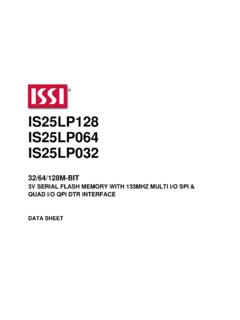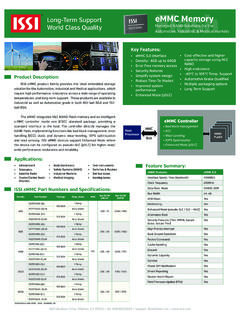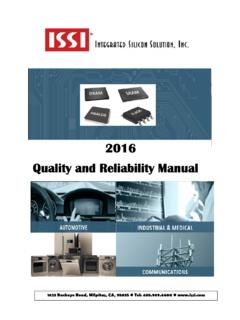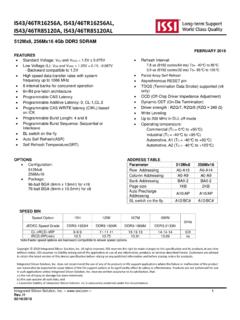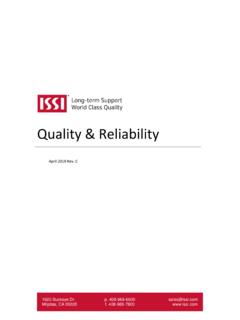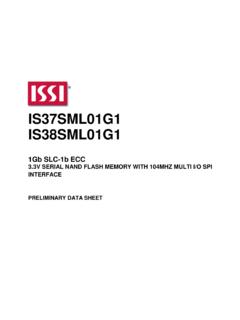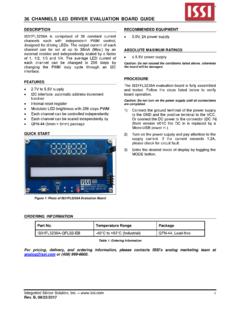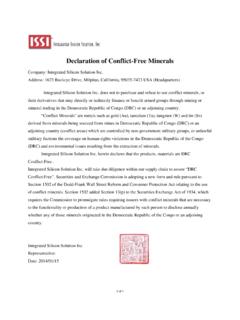Transcription of How to Choose the Right DRAM for an Application …
1 How to Choose the Right DRAM for an Application Pat Lasserre, Director, Strategic Marketing, Integrated Silicon Solution Inc. (ISSI) While price and density play large roles in selecting dynamic random access memory (DRAM), many other considerations must be taken into account. For example, long-term product support is a key consideration for many applications . Manufacturers of products with long product lifecycles, such as network infrastructure and automotive products, require lasting product support. The DRAM market's transition to double data rate, third generation (DDR3) will have implications for many of these manufacturers. In addition to long-term product support requirements, networking and automotive manufacturers also have stringent quality and wide temperature range requirements.
2 With this in mind, some chip vendors are taking measures to improve product reliability and to widen supported temperature ranges. For many handheld and mobile products, form factor and power consumption are key considerations. This is driving demand for known good die (KGD) DRAM that minimizes both active and standby power to extend battery life. Ensuring Continuity of Supply Many large DRAM suppliers are currently shifting production away from synchronous dynamic random access memory (SDRAM), DDR and DDR2 to DDR3. Market research firm iSuppli predicts that by the end of 2010 DDR3 will represent 71 percent of DRAM shipments in terms of gigabit-equivalent shipments. "With DDR3 commanding higher pricing than DDR2, memory makers realize where the big money will be in 2010," said Mike Howard, senior DRAM analyst for iSuppli.
3 "Because of this, they are more than willing to transition production to the new memory technology (DDR3)." A major factor leading this transition is Intel's latest microprocessor architecture, named Nehalem, which supports only DDR3 and is used in PCs and servers. This transition to DDR3 has significant implications to markets such as networking, automotive, industrial and medical. Many of the designs in these markets currently use SDRAM, DDR or DDR2. They require sustained product support, in many cases 10 years or greater. They will need a DRAM supplier that can provide a consistent supply of SDRAM, DDR and DDR2 for many years. Typical automotive systems have active production cycles lasting five years or more. Additionally, the development and validation phases must precede that by three to four years.
4 Changes to systems are expensive and introduce potential bugs or problems to vehicle operation. This drives the automotive segment to require that a memory configuration be available for 10 years or longer. Enhancing Long-term Reliability In addition to stable product support, reliability is also a key consideration. Package reliability is a key determinant of product reliability. Some vendors are improving package reliability by taking steps such as introducing copper leadframes and nickel-palladium-gold (NiPdAu) plating material. Better Joint Reliability Parameters such as coefficient of thermal expansion (CTE) must be taken into account when reviewing package reliability. Different CTE for materials on a printed circuit board (PCB) can cause package-related problems such as stresses at solder joints.
5 This is depicted in Figure 1. The different expansion rates cause pushing and pulling effects at the solder joint where the leadframe and the PCB interface. Figure 1. Effects of Different CTE The effects of this stress may accumulate to the point that a crack appears at the solder joint, causing an electrical discontinuity. Traditional thin small-outline packages (TSOPs) with Alloy42 leadframes can suffer from this problem. The reason for this is the devices likely would be mounted on a PCB with copper traces and landing pads. When the board is heated, the materials made of copper would expand more readily than those made of Alloy42. Some DRAM manufacturers are introducing copper leadframes for TSOPs to address this issue. A copper leadframe expands and contracts proportionally to the copper pads on the PCB, resulting in reduced stress on the solder joint.
6 Additionally, copper leadframes improve package reliability by reducing thermal resistance. Improved thermal resistance results in better heat dissipation from the chip to the leadframe, and therefore less heat-related stress to the chip. Heat stress to the chip is one of the leading causes of a non-mechanical component failure in a long-life Application . Lead-Free Product and Whisker Prevention The European environmental legislation known as Restriction of Hazardous Substances (RoHS) has driven the move to leadfree packaging. Without lead, the tin solder that electrically and physically connects components to boards can develop microscopic metal filaments known as whiskers. These whiskers can bridge metal contacts and cause a short circuit.
7 Solutions such as annealed devices with matte tin plating material can be used to minimize the risk of whisker growth. The electronics industry generally accepts an annealed matte tin plating solution. However, the International Electronics Manufacturing Initiative (iNEMI) lists NiPdAu as the preferred plating material, citing the further reduced risk for whiskers. Some DRAM suppliers use this type of plating for their copper leadframes, targeting systems with no tolerance for whisker potential. While the overall trend is toward lead-free products, some demand for leaded products still exists. This request for leaded support is mostly for ball grid array (BGA) packages. The reason some companies still request leaded product is because they are reviewing statistical reports to ensure the long-term reliability of lead-free products.
8 Thus, in some cases, markets such as networking/telecommunications and automotive, which have long-term product requirements, still require leaded support. Some companies have committed to supporting leaded BGA packages and TSOPs for the next few years. Automotive Memory Requirements Advancements in automotive electronic systems are allowing vehicles to become safer, more occupant-friendly and more fuel-efficient. For example, smart safety systems such as anti-lock braking systems (ABS), car cameras and radar systems have been introduced to help prevent collisions. Multifunction consoles offer music, Global Positioning System (GPS) navigation, Bluetooth communication, satellite radio, vehicle performance status and climate control.
9 These advancements in electronic systems are aided by the use of memories such as DRAM to store and manipulate data. Automotive systems require DRAM to be very reliable and to operate across a wide temperature range. Reliability Problem-free vehicle operation is important to automakers because recalls are very costly both in terms of dollars and customer perception. This means any IC that is used in an automotive system needs to be very reliable. To ensure high quality and reliability in harsh environments, an industry group called the Automotive Electronics Council (AEC) requires that IC manufacturers follow the AEC-Q100 specification. This specification is defined by the AEC as a "stress test qualification for integrated circuits.
10 " The intent of the AEC-Q100 is to establish standards to ensure reliable, high-quality products. Careful design of the package and choosing the Right materials and process technology can help in meeting the AEC-Q100 specification. Additionally, device reliability can be enhanced by implementing dynamic burn-in which reduces early-life failure rates. Wide Temperature Range Operation Automotive applications require a wide operating temperature range typically from -40 C to 85 C, and in some cases up to 105 C. Therefore, DRAM targeted at this segment needs to be designed with this extended temperature range in mind. It must be able to maintain its performance over the extended temperature range. To help ensure performance over temperature, additional wafer sort testing can be done and more stringent yield limits can be placed.
